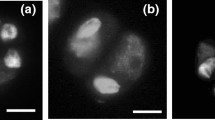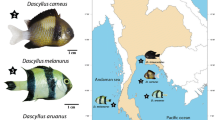Abstract
Zaprionus indianus, a member of the family Drosophilidae, is one of the commonest and most widespread species in India. It exploits a variety of fermenting fruits in nature. The nucleolar organizer regions (NORs), mitotic and polytene chromosomes were studied. A standard map of the polytene chromosomes has been constructed in order to locate break-points precisely for naturally occurring chromosomal rearrangements. Analysis of population samples of this species from four different geographical areas has revealed the presence of a single paracentric inversion in the second chromosome. Our quantitative data on the above inversion have confirmed the excess of inversion heterozygotes in nature.
Similar content being viewed by others
References
Ashburner, M. & Carsons, H. L., 1983. A checklist of maps of polytene chromosomes of Drosophilidae. Dros. Inf. Serv. 59: 148.
Balwin, G., 1982. Chromosomal polymorphism in species of the Drosophila nasuta complex in east and south east Asia. Genetica 60: 3–11.
Bennet Clark, H. C., Leroy, Y. & Tasacas, L., 1980. Species and sex-specific songs and courtship behaviour in the genus Zaprionus (Diptera: Drosophilidae). Anim. Behav. 28: 230–255.
Bicudo, H. E. M. C., 1981. Nucleolar organizer activity and its regulatory mechanisms in Drosophila species of the “Mulleri” complex and their hybrid. Caryologia 34(2): 231–253.
Bock, I. R., 1966. Drosophila argentostriata, a new species of Drosophila from New Guinea. Pap. Dept Zool. Univ. Queensland 2: 271–276.
Bridges, C. B., 1935. Salivary chromosome maps with a key to the banding of chromosomes of Drosophila melanogaster. J. Hered. 26: 60–64.
Da Cunha, A. B., Burla, H. & Dobzhansky, Th., 1950. Adaptive chromosomal polymorphism in Drosophila willistoni. Evolution 4: 212–235.
Dobzhansky, Th., Burla, H. & Da Cunha, A. B., 1950. A comparative study of chromosomal polymorphism in sibling species of the willistoni group of Drosophila. Am. Nat. 84: 229–246.
Dobzhansky, Th., 1951. Genetics and the origin of species. 3rd ed. New York: Columbia University Press.
Dobzhansky, Th., 1970. Genetics of the evolutionary process. New York: Columbia University Press.
Endow, S. A. & Gall, J. C., 1975. Differential replication of satellite DNA in polyploid tissue of Drosophila virilis. Chromosoma 50: 175–195.
Guest, W. C. & Hsu, T. C., 1973. A new technique for preparing Drosophila neuroblast chromosomes. Dros. Inf. Serv. 60: 193.
Hägele, K. & Ranganath, H. A., 1983. The chromosomes of two Drosophila races: Drosophila nasuta nasuta and Drosophila nasuta albomicans. III. Localization of nuclear organizer regions. Genetica 60: 123–128.
Hartmann-Goldstein, I. J., 1961. Enhanced differentiation of Zaprionus chromosomes by prestaining acid hydrolysis. Stain Technol. 36: 309–312.
Hennig, W., Link, B. & Leoncini, O., 1975. The location of nucleolus organizer regions in Drosophila hydei. Chromosoma 51: 57–63.
Krivshenko, J., 1959. New evidence for the homology of the short euchromatic elements of the X and Y chromosomes of Drosophila busckii with the microchromosomes of Drosophila melanogaster. Genetics 44: 1027–1040.
Mainx, F., 1958. Chromosomaler Struktur-polymorphismus bei einer Zaprionus Art. Chromosoma 9: 160–162.
Mohan, J., 1977. Multiplicity of ribosomal RNA genes in Drosophila melanogaster during growth and development. Dros. Inf. Serv. 52: 132.
Muller, H. J., 1940. Bearing of the Drosophila work on systematics. In: The new systematics (J. S. Huxley, ed.), pp. 185–268. Clarendon Press, Oxford.
Okada, T. & Carson, H. L., 1983. The genera Zaprionus Duda and Zaprionus Coquillett (Diptera: Drosophilidae) of the Oriental region and New Guinea. Kontyû 51(4): 539–553.
Pasteur, G., 1978. Affinities of Zaprionus and chromosomal evolution. Dros. Inf. Serv. 53: 121.
Pasteur, G. & Pasteur, N., 1980. Les eritères biochimiques et l'éspèce animale. Mém. Soc. zool. France no. 40.
Patterson, J. T. & Stone, W. S., 1952. Evolution in the genus Drosophila. New York, Mac Millan.
Sciandra, R. J., Abdel-Hameed, F. & Bennett, J., 1973. Chromosome complement of Zaprionus multistriatus. J. Hered. 64(1): 31–34.
Sinibaldi, R. M. & Cummings, M. R., 1981. Localization and characterization of rDNA in D, tumiditarsus. Chromosoma 81: 655–671.
Spear, B., 1974. The genes for ribosomal RNA in diploid and polytene chromosomes of Drosophila melanogaster. Chromosoma 48: 159–179.
Strickberger, M. W., 1962, Experiments in genetics with Drosophila. Wiley, New York and London.
Throckmorton, L. H., 1975. The phylogeny, ecology and geography of Drosophila. In: Handbook of genetics (Ed. R. C. King), pp. 421–469. New York: Plenum Press.
Tsacas, L., David, J., Allemand, R., Pasteur, G., Chassagnard, M. T. & Derridj, 1977. Biologie évolutive du genre Zaprionus. Recherches sur le complexe spécifique de Zaprionus tuberculatus (Diptera: Drosophilidae). Annls Soc. ent. Fr. (N.S.) 13(2): 391–415.
Tsacas, L., Lachaise, D. & David, J. R., 1981. Composition and biogeography of the Afrotropical Drosophilid fauna. In: The genetics and biology of Drosophila (Eds. M. Ashburner, H. L. Carson & J. H. ThompsonJr.) pp. 195–259. Academic Press London.
Wilson, F., Wheeler, M. R., Margaret, H. & Kambysellis, M., 1969. Cytogenetic relations in the Drosophila nasuta subgroup of the immigrans group of species. Univ. Texas Publ. 6918: 207–254.
Wheeler, M. R., 1981. The Drosophilidae. A taxonomic overview. In: The genetics and biology of Drosophila (eds. M. Ashburner, H. L. Carson and J. H. ThompsonJr.), pp. 1–97. Academic Press London.
Author information
Authors and Affiliations
Rights and permissions
About this article
Cite this article
Gupta, J.P., Kumar, A. Cytogenetics of Zaprionus indianus Gupta (Diptera: Drosophilidae): Nucleolar organizer regions, mitotic and polytene chromosomes and inversion polymorphism. Genetica 74, 19–25 (1987). https://doi.org/10.1007/BF00055090
Received:
Accepted:
Issue Date:
DOI: https://doi.org/10.1007/BF00055090




